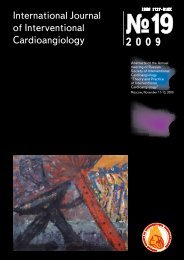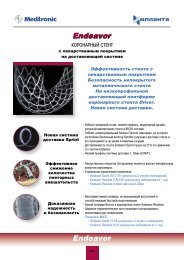Results of Coronary Stenting using the Stents with
Results of Coronary Stenting using the Stents with
Results of Coronary Stenting using the Stents with
You also want an ePaper? Increase the reach of your titles
YUMPU automatically turns print PDFs into web optimized ePapers that Google loves.
Miscellaneous<br />
Fig. 1. Angiopulmonography<br />
Fig. 2. Angiography <strong>of</strong> <strong>the</strong> descending thoracic aorta<br />
Fig. 3. Angiography <strong>of</strong> <strong>the</strong> left bronchial artery<br />
by anti-worm agent Mebendazol. This <strong>the</strong>rapy led<br />
to <strong>the</strong> stabilization <strong>of</strong> patient’s condition. In 5 days<br />
after <strong>the</strong> embolization <strong>of</strong> <strong>the</strong> left bronchial artery he<br />
was extubated, pulmonary bleeding did not recur.<br />
Chest X-ray examination performed in 2 weeks after<br />
<strong>the</strong> embolization revealed <strong>the</strong> resolution <strong>of</strong> bilateral<br />
pneumonia. The patient was discharged in a satisfactory<br />
condition.<br />
We present a case <strong>of</strong> successful endovascular<br />
treatment <strong>of</strong> pulmonary bleeding. Bronchial arteries<br />
are <strong>the</strong> source <strong>of</strong> pulmonary bleeding in more<br />
than 90% <strong>of</strong> cases. The bleeding from <strong>the</strong> pulmonary<br />
arterial system (e.g., pulmonary arteriovenous<br />
malformation, pulmonary endometriosis, pulmonary<br />
Fig. 4. Total embolization <strong>of</strong> <strong>the</strong> left bronchial artery<br />
<strong>with</strong> PVA particles.<br />
arterial aneurysm, etc.) is rare and occurs in approximately<br />
5%. In <strong>the</strong> remaining 5% <strong>of</strong> cases <strong>the</strong> source<br />
<strong>of</strong> bleeding is not found in bronchial systemic collateral<br />
arteries. It can be located in <strong>the</strong> internal thoracic<br />
artery, <strong>the</strong> thyrocervical trunk <strong>of</strong> <strong>the</strong> subclavian artery,<br />
<strong>the</strong> lateral branches <strong>of</strong> <strong>the</strong> subclavian and axillary<br />
arteries, <strong>the</strong> intercostal arteries and <strong>the</strong> inferior<br />
diaphragmatic artery (5, 6). In most cases pulmonary<br />
bleeding is caused by acute or chronic inflammatory<br />
lung disease. Etiological causes <strong>of</strong> pulmonary bleedings<br />
are presented in Table 1.<br />
Pulmonary blood flow in patients <strong>with</strong> acute or<br />
chronic pulmonary diseases is decreased due to<br />
hypoxia-caused vasoconstriction, thrombosis and<br />
Clinical Case <strong>of</strong> a Successful Endovascular Management <strong>of</strong> Pulmonary Bleeding<br />
59
















